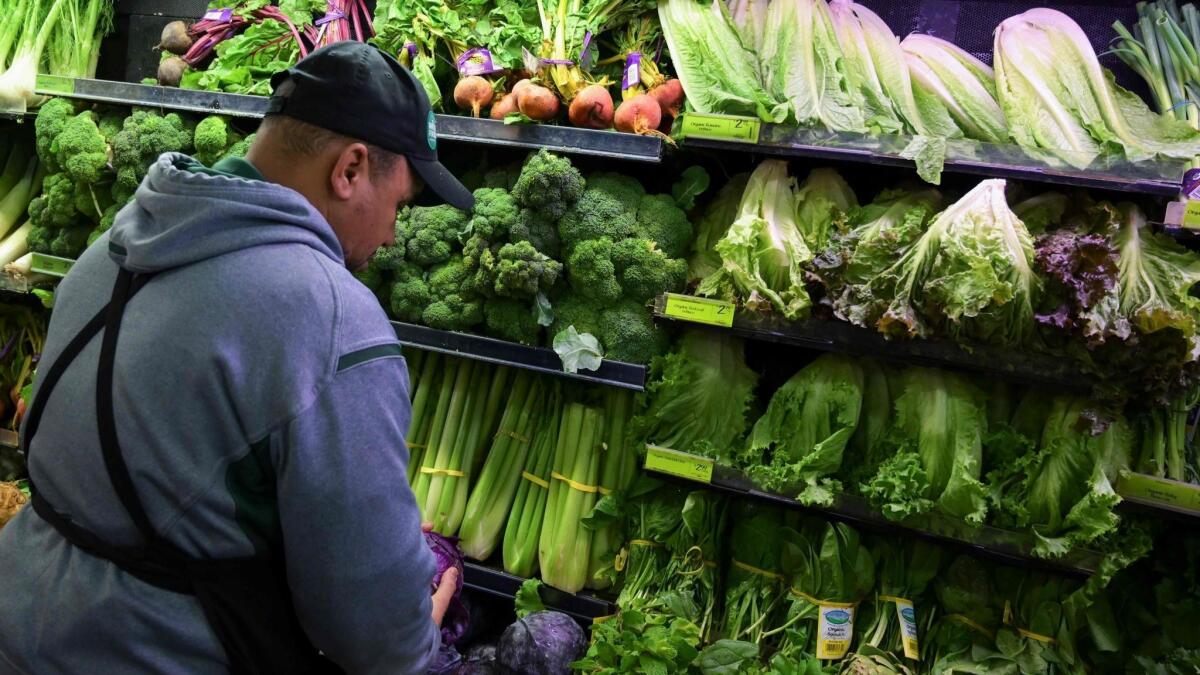Government shutdown: FDA does less for food safety than you probably think

- Share via
Three weeks into the federal government shutdown, a new worry has emerged: the U.S. Food and Drug Administration’s food-safety inspections.
On Wednesday, FDA Commissioner Scott Gottlieb tweeted that his agency would work to continue inspections, but subject to limitations. Shortly afterward, he clarified, in a separate tweet, that high-risk food inspections would continue. There are two food categories for the FDA: high-risk, such as seafood and soft cheeses; and low-risk, such as cereals.
The FDA inspects around 80% of the country’s food supply, including fruit and vegetables, bottled water, cheese, and prepackaged goods. It does not oversee raw meat, poultry, or any products with eggs, which are within the purview of the United States Department of Agriculture; the government shutdown is currently not affecting those slaughterhouse inspections.
Should Americans worry about the food the FDA can’t inspect during the shutdown?
A straight answer can be as complicated as a grocery store supply chain, and the answer varies according to whom you ask.
Food safety expert Sarah Taber, a consultant whose company, Boto Waterworks, monitors fruit and vegetable facilities, is unperturbed. She said the FDA does a lot less than you think it does.
“People are freaking out the FDA isn’t going to do its job, that they have a magical force field that’s been extinguished,” she said. “They haven’t been doing enough for decades.” Even for high-risk facilities, the FDA is required only to inspect them once every three years.
Taber pointed to outbreaks in 2018 that occurred when the government was not shut down. Months before the most recent scare, E. coli found in romaine lettuce killed five people and hospitalized hundreds. Last July, parasites on Del Monte vegetable trays hospitalized more than 70 people in four states. In October, Kellogg’s recalled its Honey Smacks cereal after more than 70 people were sickened in 31 states.
Taber compared their situation to the burning of the Library of Alexandria in 48 A.D. “People say it was burned down by barbarians. It was falling apart due to underfunding for centuries. That’s where we are right now with FDA inspections; just substitute ‘years’ for centuries,” she said.
Barbara Kowalcyk, a professor in the Department of Food Science and Technology at Ohio State University, takes a more cautious view. “Obviously, consumers should be concerned,” she said. “The inspections the FDA does can identify problems before they have a chance to make people sick. Sure, they’re underfunded, but a functioning FDA is better than what we have today.”
The FDA oversees $2.5 trillion worth of consumer products, food and pharmaceuticals, according to its website. The 2018 FDA budget is $9.11 per year per American. According to Gottlieb, the agency performs around 8,400 inspections a year. He also said, via Twitter, that the agency normally conducts about 160 a week, 31% of which would be labeled high-risk.
What experts can’t disagree on is that the longer the shutdown lasts, the more uninspected food will enter the supply chain.
“People shouldn’t panic or stop buying their usual foods,” said Sarah Sorscher, the deputy director of regulatory affairs at advocacy group the Center for Science in the Public Interest, highlighting the efforts the FDA is making to get inspectors out to high-risk facilities. Because inspections typically don’t take place during the holidays, this is the first week that the shutdown is directly impacting the FDA.
“But the longer this drags on, the more risk there is,” Sorscher said. She also fears the effect on morale may hinder the FDA’s ability to retain qualified people.
“There’s a short-term and a long-term issue,” said Marion Nestle, the Paulette Goddard Professor of Nutrition, Food Studies, and Public Health at New York University, as well as author of several books on food politics. She doesn’t think the short-term consequences will be a big problem, unless an outbreak requires investigation and the FDA needs to move quickly. She worries about the effects of a longer-term absence of routine FDA inspection.
“It sets up a situation [of] when the cat’s away, the mice will play,” Nestle said. “That’s the real worry.”
For consumers, the safest course of action may be then to recalibrate personal risk tolerance as the days, weeks, or months progress. Unpasteurized juices, soft cheese and raw fish have always carried a relatively higher risk, for example, but even in normal times, that still amounts to a low chance of getting sick. The fact that the FDA is prioritizing its limited funds on these riskier foods might provide relief for some and not for others. Will there be a point at which sprouts, ice cream, and pre-washed leafy greens are off the table as well? Pregnant women are well-versed in this diet-balancing act.
Beyond the FDA, Sorscher said she’s heard rumblings that USDA workers are becoming fed up with the shutdown and might start calling in sick.
“If they stop showing up, we’d see some serious impact on the country’s meat supply. That’s going to be something people notice,” she said.
More to Read
Inside the business of entertainment
The Wide Shot brings you news, analysis and insights on everything from streaming wars to production — and what it all means for the future.
You may occasionally receive promotional content from the Los Angeles Times.










